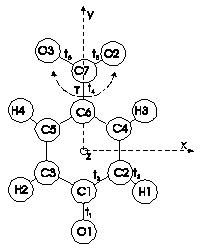|
 |
||
|
Rigid Bodies in Powder Diffraction
In many structures, groups of atoms (molecules or coordination polyhedra) have a well established structure, are not completely independent, and therefore form a relatively rigid unit. Typical examples are the cyclopentadienyl anion or the benzene ring. Rigid bodies have been a common tool in single crystal X-ray diffraction for more than 30 years, and are especially valuable when the quality of the data is low, the ratio of observations to parameters is low, and/or the structure is very complicated (e.g. proteins). According to Scheringer there are several general advantages for using rigid bodies:
Furthermore, it is often impossible to refine individual atomic positions if disorder occurs. By using rigid bodies it might be possible to model disorder even in the case of powder data. The advantages which led to the introduction of rigid bodies in single crystal analysis are even more valid for powder data. Interestingly, very little has been done so far in this field and only a few Rietveld refinement programs offer a rigid body option. The aim of this paper is to give a practical guide to the powder community to explore the possibilities of rigid bodies in Rietveld refinement. A pre-version of this paper was originally written for a manual of a workshop on ”Ab initio structure determination of molecular solids from powder diffraction” held at Bayreuth, September 25.-28. 1997. Although there are many different ways to set up a rigid body, the basics are similar. In the following paper, the notation of the widely used Rietveld refinement program GSAS is used. ` |
||







 To date, only a few papers have been published about the practical use of rigid bodies. Although being a standard tool in single crystal analysis, very little attention has been paid to rigid bodies in powder diffraction. Presumably less than 5% of the ‘Rietveld’-community make active use them.
To date, only a few papers have been published about the practical use of rigid bodies. Although being a standard tool in single crystal analysis, very little attention has been paid to rigid bodies in powder diffraction. Presumably less than 5% of the ‘Rietveld’-community make active use them.